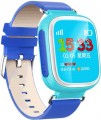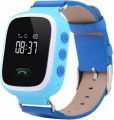Size
The size of the display installed in the gadget; for round screens, respectively, the diameter is indicated.
A larger screen, on the one hand, is more convenient to use, on the other hand, it significantly affects the dimensions of the entire device, which is especially critical for wearable gadgets. Therefore, manufacturers choose the display size in accordance with the purpose and functionality of each specific model — so that there is enough space on the screen and the device itself is not too bulky.
It is also worth mentioning that screens with a similar size may have different aspect ratios. For example, traditional smartwatches are usually equipped with square or round panels, while in fitness trackers, screens are often made elongated in height.
Screen resolution
Screen size in dots (pixels) horizontally and vertically. In general, this is one of the indicators that determine the image quality: the higher the resolution, the clearer and smoother the picture on the screen (with the same size), the less noticeable are the individual dots. On the other hand, an increase in the number of pixels affects the cost of displays, their power consumption and requirements for a hardware platform (more powerful hardware is required, which itself will cost more). In addition, the specifics of using smartwatches is such that there is simply no need to install high-resolution screens in them. Therefore, modern wrist accessories use displays with a relatively low resolution: for example, 320x320 with a size of about 1.6" is considered quite sufficient even for premium watches.
PPI
The density of dots on the screen of the gadget, namely, the number of pixels that are on each inch of the panel vertically or horizontally.
The higher the PPI, the higher the detail of the screen, the clearer and smoother the image is. On the other hand, this indicator affects the price accordingly. Therefore, the higher the density of points, the more advanced, usually, this gadget is in terms of general capabilities. However, when choosing a screen, manufacturers take into account the general purpose and functionality of the device; so that even a small number of PPIs usually does not interfere with comfortable use.
CPU frequency
The clock speed of the processor (CPU) installed in the gadget.
Theoretically, a high clock speed has a positive effect on speed and performance; however, in fact, this parameter has a purely reference and promotional value. This is due to the fact that the real capabilities of the CPU depend on a number of other factors, and the overall performance of the system also depends on the properties of the rest of the hardware. In addition, manufacturers select processors in such a way that their performance is guaranteed to be sufficient, taking into account the planned specialization and functionality of the gadget. Therefore, when choosing this parameter, you can not pay much attention.
Weight
In most cases, the weight of the watch body itself is indicated as the weight of the model, since the strap is removable and can be replaced with another one. However, there are also models when the weight is presented with an included strap. Anyway, if the manufacturer indicates a specific method of measuring weight (with or without a strap), we add this information.

